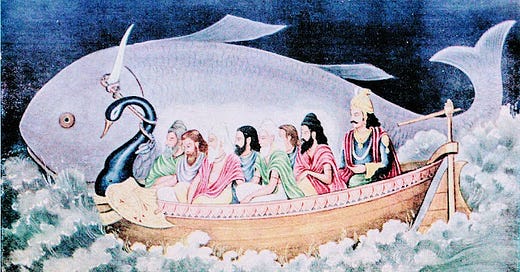Parashas Noach: Migdal Bavel and the Hindu Account of the Mabul
This week's Torah content has been sponsored by an anonymous donor, in memory of her grandmother, Golda Henya bat Devora a"h.
Click here for a printer-friendly version of this article, and click here for an audio version.
Parashas Noach: Migdal Bavel and the Hindu Account of the Mabul
Rashi (Bereishis 11:1) mentions three possible motives of the Dor Ha'Haflagah (Generation of the Dispersion) for building the tower. According to his third explanation, the people said: "Once every 1656 years, the firmament becomes unstable, as it did in the time of the Mabul (Flood). Come, let us make supports for it!" (Bereishis Rabbah 38:6). On a basic level, Chazal are teaching us that the Dor Ha'Haflagah denied that the Mabul was Divine punishment for the sinfulness of mankind; likewise, they denied Hashem’s promise that He would never bring such destruction again. Instead, they viewed the Mabul as a natural, cyclical phenomenon – one which had nothing to do with morality, and which could be averted by taking the proper technological precautions.
Up until now, I assumed that this midrash was mere homiletics, having nothing to do with historical fact. After all, how could Chazal know what the Dor Ha'Haflagah really thought? This year, however, I discovered that there really were people who believed this about the Mabul! I’m currently in the middle of reading Rabbi on the Ganges: A Jewish-Hindu Encounter, by Rabbi Dr. Alan Brill. The author summarizes the Hindu-Indian account of the Mabul, as recorded in the Puranas, a sacred text which was written down during the Gupta era (350-550 CE):
The Puranas present many related versions of the flood story, which all bear an uncanny resemblance to the biblical flood story. All of these accounts agree that the flood story’s protagonist is a man named Manu. Like Noah, Manu is described as a virtuous individual “who, by penances and prayers, had won the favor of the lord of heaven” (Shatapatha Brahmana I:8 Matsya Purana). Both Manu and Noah had three sons before the flood – Charma, Sharma, and Yapeti, and Ham, Shem, and Japheth, respectively. In Genesis, the cause of humanity’s destruction is that the “wickedness of man was great in the earth” (ch 6). In the story of Manu, however, the destruction of the world was part of the natural order of things, rather than as a divine punishment. (p.112)
Apparently, the cyclical flood theory wasn’t merely a didactic element of a midrashic fiction, but was a real belief held by actual human beings! Let us compare the response of the Dor Ha’Haflagah as described by the midrash with the Hindu response described in the Puranas. Chazal rightly condemn the Dor Ha’Haflagah for their denial of the true cause of the Mabul. They knew what Noach had told them based on nevuah and rejected it anyway. In contrast, the Hindus didn’t have access to a living navi to frame the event from a true Divine perspective. Where does that leave us today? We also don’t have a living navi. How should we respond to a cyclical natural disaster?
The answer lies in the Rambam’s codification (Hilchos Taaniyos 1:1-3) of the Jewish response to tzarah (catastrophe):
It is a positive mitzvah of the Torah to cry out and to sound the trumpets on every tzarah that befalls the community … such as drought, epidemic, locusts, and the like … This principle is one of the darchei teshuvah (ways of repentance), that at a time of the onset of an affliction, when the [people] cry out and sound the trumpets, everyone will know that it was because of their evil conduct that this bad occurrence befell them … But if they do not cry out and do not sound the trumpets, but instead say, “This is minhago shel olam (a natural event) which befell us, and this affliction is a mikreh (chance occurrence)” - behold, this is a derech achzarius (way of cruelty) and will cause them to cling to their evil conduct, and [this] affliction and others will increase.
The Rambam doesn’t differentiate between cyclical and non-cyclical catastrophes. Apparently, it doesn’t matter whether the tzarah follows a natural cycle or not. What matters is whether we respond to it by doing teshuvah or whether we dismiss it as “the way of the world” and persist in our behavior. Every tzarah ought to prompt us to engage in teshuvah, no matter what the cause or frequency. In this framework, even if the Mabul were a cyclical disaster – as believed by the Dor Ha'Haflagah and the Hindus – it wouldn’t make a difference. Even without access to a navi today, we can know with 100% certainty that the correct response to any tzarah is teshuvah.
Substack: rabbischneeweiss.substack.com/
Patreon: patreon.com/rabbischneeweiss
YouTube: youtube.com/rabbischneeweiss
Instagram: instagram.com/rabbischneeweiss/
"The Stoic Jew" Podcast: thestoicjew.buzzsprout.com
"The Mishlei Podcast": mishlei.buzzsprout.com
"Rambam Bekius" Podcast: rambambekius.buzzsprout.com
"Machshavah Lab" Podcast: machshavahlab.buzzsprout.com
"The Tefilah Podcast": tefilah.buzzsprout.com
Blog: kolhaseridim.blogspot.com/
WhatsApp Group: https://chat.whatsapp.com/GEB1EPIAarsELfHWuI2k0H
Amazon Wishlist: amazon.com/hz/wishlist/ls/Y72CSP86S24W?ref_=wl_sharel




